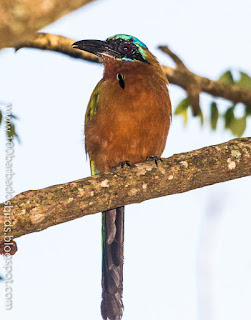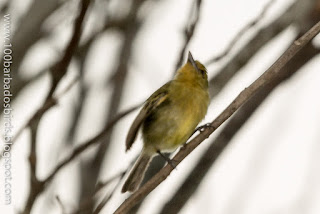 |
| White-tailed Sabrewing - Campylopterus ensipennis |
I never thought that there would have been a problem getting
a flight from Trinidad to Tobago, so I
left the booking until a week before we flew out to Trinidad only to find that
the dates and times I had been checking was now unavailable – all seats were
booked. The only option we had was to
fly out Thursday afternoon, overnight in Tobago, and return Friday afternoon so
we took it. The benefits: I could start
birding earlier on Friday and visit more hotspots which I hoped would mean
seeing more birds. The downside: paying
for a room for the night out of an already tight budget. We found a room at a good price which was
close to the airport and arranged a rental car which was to be collected the
night we arrived. All was set for the
following day of birding in Tobago.
I awoke around 5:30am to the sounds of my first lifer for
the island, a noisy turkey-like bird called Rufous-vented Chachalaca, these birds were everywhere on the island
no wonder it is Tobago’s national
bird. I was on the road at about 5:45am
and made my first stop at Crown Point, a beach near the bottom of the airport’s
runway. Brown Pelicans and Common
Terns were busy feeding close to the shore.
A few more birds were out to sea on a boat but it was difficult to make
out their types. I also added my first
Laughing Gull and Grey Kingbird for the trip.
I then went in search of Bon Accord Sewage Treatment Plant,
one of the birding hotspots of the island. With no GPS available I followed a
map and road signs which lead me to a sign which said Bon Accord Mangroves. Birding in this area was productive, landing
me lifers such as Mangrove Cuckoo, Brown-crested Flycatcher, White-winged
Becard and Scrub Greenlet but
I could not find the Sewage treatment Plant.
I returned to the
apartment at about 8:00am and was back on the road with the rest of the family,
at 9:00am. Our first stop was the Tobago
Plantation.
The Tobago Plantation
 |
| Black-crowned Night-Heron - Nycticorax nycticorax |
The Tobago
Plantation was not far from where we stayed. As we drove into the property there was a
large lake on the right side. Black-crowned
Night Herons of all ages were the most numerous birds on the lake followed
closely by Anhingas and some Black-bellied Whistling Ducks. On the Golf course to the left of the guard
station was a flock of Giant Cowbirds, a lifer for me. A local couple was busy photographing the
Whistling Ducks and agreed to take me to the Bon Accord Sewage Treatment Plant.
Bon Accord Sewage Treatment Plant
 |
| Least Grebe - Tachybaptus dominicus |
I followed the couples
to Bon Accord and realized I was just a short distance from the sewage plant earlier.
There were a number of ponds with birds
in them. My target bird, Least Grebe,
a lifer, was seen in a small pond close to the back of the plant. A surprise which brought me some excitement
was the presence of two Glossy Ibis, which are rare to the island. I later reported that sighting to the
country’s rare bird committee. Another first
for the trip was a Short-billed Dowitcher. I spent close to an hour at the treatment
plant before saying goodbye to our friends who were taking photographs of the
Glossy Ibis.
The detour to the
sewage treatment plant caused us an hour and I decided to make adjustments. We travelled on the east coast towards our
next intended stop Argyle Falls some 22 miles away, along the winding
roads of Tobago. We made one stop at
Barbados Bay and then was on the road again. We arrived at Argyle Falls about 12:00 noon
and started our tour.
Argyle Falls
 |
| Trinidad Motmot - Momotus bahamensis |
It was a 15 – 30
minute easy walk to the falls. The path
was covered with a canopy of trees and bamboo with various birds calling. The lifers I picked out from among the trees
were Trinidad Motmot, finally! Cocoa Woodcreeper, White-fringed Antwren and Fuscous Flycatcher. We spent just over two hours at the falls, it
was cool and refreshing. Our next stop was
supposed to be the Speyside Lookout but a wrong turn on leaving Argyle Falls
put us onto the Main Ridge Forest Reserve road and because of the time we
continued.
Main Ridge Forest Reserve
 |
| Green-rumped Parrotlet - Forpus passerinus |
The trip through the forest was birding on wheels; we saw
and heard Orange-winged Parrots, two
Rufous-tailed Jacamar perched along
the road, a Green-rumped Parrotlet on
the powerline, Red-rumped Woodpecker
on a metal utility Pole and a Great
Black Hawk, both lifers. We made a
stop at the reserve’s visitor center which was closed due to water outage. The guard dog was very friendly allowing us to
pet him and tried to prevent us from leaving. The leaf cutter ant’s super highway through
the lawns at the rare of the visitor’s center was a sight to behold and worth a
mention in this bird blog. We were told
of a stop just downhill of the reserve where it was possible to see the White-tailed Sabrewing and maybe even the Ruby-topaz Hummingbird. We
drove about a mile or so and came upon a roadside stand with bird feeders setup
under a shed and a feeding table with fruit in the background. I paid $14TT or approx. $2.30US to spend as
much time as I wished at the feeding stations. Two types of hummingbirds were busy visiting
the feeders – the White-necked Jacobins
and yes the White-tailed Sabrewing. I was as happy as a kid in a candy store
because I was told that it would be difficult to see the Sabrewing as it was in
its nesting season. Disappointingly,
there was no Ruby-topaz to be seen, none came to the feeder. Our drive through the forest took us three
hours and we were well behind time but I still wanted to make one more stop - Grafton
Estate.
Grafton Estate
 |
| White-fringed Antwren - Formicivora grisea |
After a series of
wrong turns, turn arounds and flat out being lost, thanks to the faulty
information fed to me by my navigator and her map. We finally arrived at Grafton Estate after
5:30pm an hour and a half behind our scheduled time, which was feeding time at 4:00pm. There were no signs that a feeding took place
that afternoon so we took a quick walk on a few of the paths. In the 30 minutes I spent I recorded two
lifers – I finally got the Ruby-topaz Hummingbird but a female, not as
colourful as the males, and a Yellow-breasted
Flycatcher.
We were now really
behind time when we left Grafton around 6:00pm with our check-in time being
6:30pm and our flight due for departure at 8:00pm. We still had to stop for a quick bite and
return the car before heading to the airport.
It was no surprise then, when we missed our check-in time and thus our flight,
but was accommodated on the next one scheduled to leave at 8:30pm. I enjoyed birding in Tobago and will be back
for sure.
New Species for the Day: 29
New Lifers for the Day: 16
Total Species for the Trip: 136
Total Lifers for the Trip: 92
New Lifers for the Day: 16
Total Species for the Trip: 136
Total Lifers for the Trip: 92
Mount
Pleasant: Rufous-vented
Chachalaca, Ear Dove, Caribbean Martin
Crown
Point: Brown Pelican, Laughing
Gull, Common Tern, Gray Kingbird
Bon
Accord Mangrove: White-cheeked
Pintail, Magnificent Frigatebird, Brown-crested Flycatcher, Mangrove
Cuckoo, White-winged Becard, Scrub Greenlet
Tobago
Plantation: Giant Cowbird, Black-crowned
Night Heron, Green Heron.
Bon
Accord Sewage Treatment Ponds: Least
Grebe, Glossy Ibis, Short-billed Dowitcher.
Argyle
Falls: Trinidad Motmot,
White-fringed Antwren, Cocoa Woodcreeper, Fuscous Flycatcher, Black-face
Grassquit.
Main
Ridge Forest Reserve: Great
Black Hawk, White-tailed Sabrewing, White-tailed Sabrewing
Grafton
Estate: Ruby-topaz Hummingbird, Yellow-breasted Flycatcher
 |
| Brown-crested Flycatcher - Myiarchus tyrannulus |
 |
| Tropical Mockingbird - Mimus gilvus |
 |
| Wattled Jacana - Jacana jacana |
 |
| Short-billed Dowitcher - Limnodromus griseus |
 |
| Tricolored Heron - Egretta tricolor |
 |
| Rufous-breasted Hermit - Glaucis hirsutus |
 |
| Rufous-tailed Jacamar - Galbula ruficauda |
 |
| Pale-vented Pigeon - Patagioenas cayennensis |
 |
| White-tailed Sabrewing - Campylopterus ensipennis |
 |
| Red-rumped Woodpecker - Veniliornis kirkii |
 |
| Ruby-topaz Hummingbird - Chrysolampis mosquitus |
 |
| Trinidad Motmot - Momotus bahamensis |
 |
| Yellow-breasted Flycatcher - Tolmomyias flaviventris |
No comments:
Post a Comment